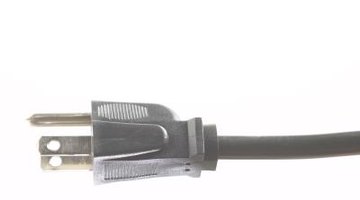Can You Hard Wire a Plug-In Appliance?
To hardwire an appliance means to permanently integrate it into a building’s circuits by connecting it directly and permanently to a supply, as opposed to pressing a plug into an outlet, where the outlet is hardwired. Converting hardwired appliances to use plugs and outlets is more common than the reverse, but it can be done safely.
The Reasoning

The molding of plugs can deteriorate with frequent insertion into and removal from outlets, especially if the cord is pulled, not the body of the plug. The tines of plugs can deform and corrode if exposed to adverse conditions, particularly high humidity atmospheres. These issues are eliminated by hardwiring. Further, hardwired connections have markedly less resistance than do plug-in connections. While this is of minimal consequence when using small appliances, it nonetheless represents a waste of electricity. The reduced resistance is a more consequential issue when fitting larger appliances such as water heaters, garbage disposals and dishwashers.
Junction Boxes
It is dangerous, and almost certainly illegal by virtue of contravening code, to directly connect an appliance cord to a circuit by simply winding the color-matched wires around each other. A proper junction box must be used. Junction boxes have separate terminals for each of the three wires in a 110-volt circuit; the hot -- sometimes called “live” -- the neutral, sometimes called “return,” and the ground. The box must be attached to a solid substrate according to the manufacturer’s instructions, in a location where it will not be likely to incur accidental damage.
Making the Connection
Hardwired appliances are typically connected to their supply using a Romex-type cable; a relatively stiff, non-metallic-sheathed cable color-coded to indicate its safe maximum operating voltage. Plug-in appliance cords are typically rather more flexible, made with wire -- not cable -- and without color-coding. If you notice any heating of the cord while the appliance is still plugged in, it may be advisable to open the appliance and run Romex-type cable from a junction box to the appliance.
The Exceptions
Some heavy-drain appliances that are common in residences cannot be hardwired to regular circuits; ranges and clothes dryers are among these exceptions. Such appliances, which run on 220 volts, will not function correctly if hardwired into 110-volt, and may sustain damage. They can be hardwired into 220-volt circuits, but most circuits in residences are 110 volts only. Further circuit testing is needed to confirm the voltage before proceeding.
Generators
According to the California Energy Commission, Consumer Energy Center, two of the seven basic rules for safe generator use involve connecting generators to building circuits; one instance involves hardwiring. The Commission states that generators should never be connected directly into a building’s wiring; electricity generated can “back-feed” into power lines and there be transformed by mains equipment into thousands of volts. This charge could be deadly to linesmen even miles away. The only way to safely hardwire a generator to a building’s circuits is to use a “cut-off switch that will automatically disconnect the home from the power grid when the generator is being used.”
References
Writer Bio
John Cagney Nash began composing press releases and event reviews for British nightclubs in 1982. His material was first published in the "Eastern Daily Press." Nash's work focuses on American life, travel and the music industry. In 1998 he earned an OxBridge doctorate in philosophy and immediately emigrated to America.
Photo Credits
- Hemera Technologies/AbleStock.com/Getty Images
More Articles



